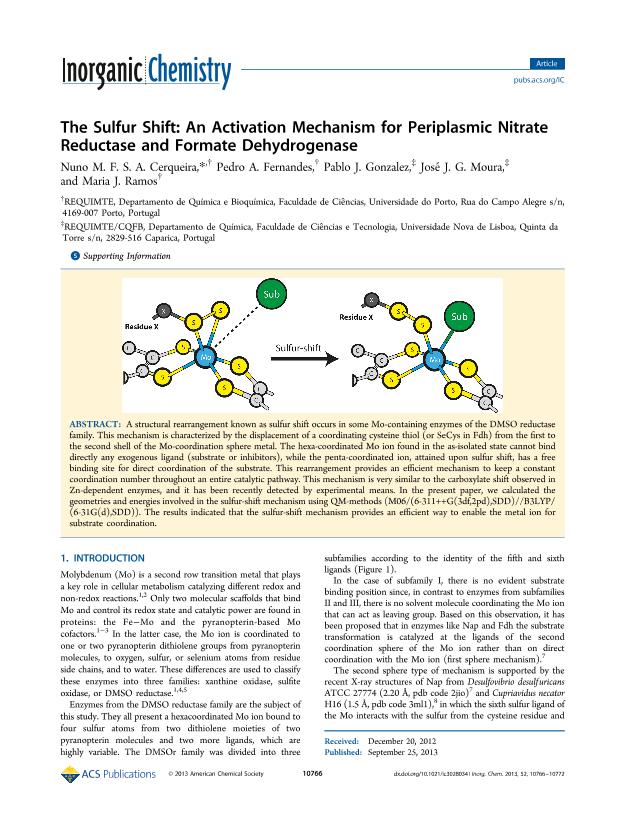Mostrar el registro sencillo del ítem
dc.contributor.author
Cerqueira, Nuno M. F. S. A.
dc.contributor.author
Fernandes, Pedro A.
dc.contributor.author
González, Pablo Javier

dc.contributor.author
Moura, José J. G.
dc.contributor.author
Ramos, Maria J.
dc.date.available
2016-07-14T20:36:14Z
dc.date.issued
2013-09
dc.identifier.citation
Cerqueira, Nuno M. F. S. A.; Fernandes, Pedro A.; González, Pablo Javier; Moura, José J. G.; Ramos, Maria J.; The Sulfur Shift: An Activation Mechanism for Periplasmic Nitrate Reductase and Formate Dehydrogenase; American Chemical Society; Inorganic Chemistry; 52; 19; 9-2013; 10766-10772
dc.identifier.issn
0020-1669
dc.identifier.uri
http://hdl.handle.net/11336/6501
dc.description.abstract
A structural rearrangement known as sulfur shift occurs in some Mo-containing enzymes of the DMSO reductase family. This mechanism is characterized by the displacement of a coordinating cysteine thiol (or SeCys in Fdh) from the first to the second shell of the Mo-coordination sphere metal. The hexa-coordinated Mo ion found in the as-isolated state cannot bind directly any exogenous ligand (substrate or inhibitors), while the penta-coordinated ion, attained upon sulfur shift, has a free binding site for direct coordination of the substrate. This rearrangement provides an efficient mechanism to keep a constant coordination number throughout an entire catalytic pathway. This mechanism is very similar to the carboxylate shift observed in Zn-dependent enzymes, and it has been recently detected by experimental means. In the present paper, we calculated the geometries and energies involved in the sulfur-shift mechanism using QM-methods (M06/(6-311++G(3df,2pd),SDD)//B3LYP/(6-31G(d),SDD)). The results indicated that the sulfur-shift mechanism provides an efficient way to enable the metal ion for substrate coordination.
dc.format
application/pdf
dc.language.iso
eng
dc.publisher
American Chemical Society

dc.rights
info:eu-repo/semantics/openAccess
dc.rights.uri
https://creativecommons.org/licenses/by-nc-sa/2.5/ar/
dc.subject
Molybdenum
dc.subject
Sulfur-Shift
dc.subject
Nitrate Reductase
dc.subject
Formate Dehydrogenase
dc.subject.classification
Biofísica

dc.subject.classification
Ciencias Biológicas

dc.subject.classification
CIENCIAS NATURALES Y EXACTAS

dc.title
The Sulfur Shift: An Activation Mechanism for Periplasmic Nitrate Reductase and Formate Dehydrogenase
dc.type
info:eu-repo/semantics/article
dc.type
info:ar-repo/semantics/artículo
dc.type
info:eu-repo/semantics/publishedVersion
dc.date.updated
2016-07-06T15:45:58Z
dc.journal.volume
52
dc.journal.number
19
dc.journal.pagination
10766-10772
dc.journal.pais
Estados Unidos

dc.journal.ciudad
Washington
dc.description.fil
Fil: Cerqueira, Nuno M. F. S. A.. Universidad de Porto; Portugal
dc.description.fil
Fil: Fernandes, Pedro A.. Universidad de Porto; Portugal
dc.description.fil
Fil: González, Pablo Javier. Universidade Nova de Lisboa. Faculdade de Ciencias e Tecnologia. Departamento de Química; Portugal. Consejo Nacional de Investigaciones Científicas y Técnicas. Centro Científico Tecnológico Santa Fe; Argentina
dc.description.fil
Fil: Moura, José J. G.. Universidade Nova de Lisboa. Faculdade de Ciencias e Tecnologia. Departamento de Química; Portugal
dc.description.fil
Fil: Ramos, Maria J.. Universidad de Porto; Portugal
dc.journal.title
Inorganic Chemistry

dc.relation.alternativeid
info:eu-repo/semantics/altIdentifier/url/http://pubs.acs.org/doi/abs/10.1021/ic3028034
dc.relation.alternativeid
info:eu-repo/semantics/altIdentifier/doi/http://dx.doi.org/10.1021/ic3028034
dc.relation.alternativeid
info:eu-repo/semantics/altIdentifier/doi/10.1021/ic3028034
Archivos asociados
